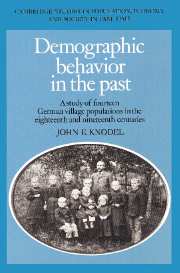 Demographic Behavior in the Past
Demographic Behavior in the Past Book contents
- Frontmatter
- Contents
- List of tables
- List of figures
- Acknowledgements
- PART I INTRODUCTION
- PART II MORTALITY
- 3 Infant and child mortality: levels, trends and seasonality
- 4 Infant and child mortality: socio-economic and demographic differentials
- 5 Maternal mortality
- PART III FAMILY FORMATION
- PART IV MARITAL REPRODUCTION
- PART V INTERRELATIONSHIPS IN DEMOGRAPHIC BEHAVIOR
- PART VI CONCLUSION
- Appendices
- Bibliography
- Index
3 - Infant and child mortality: levels, trends and seasonality
Published online by Cambridge University Press: 04 August 2010
- Frontmatter
- Contents
- List of tables
- List of figures
- Acknowledgements
- PART I INTRODUCTION
- PART II MORTALITY
- 3 Infant and child mortality: levels, trends and seasonality
- 4 Infant and child mortality: socio-economic and demographic differentials
- 5 Maternal mortality
- PART III FAMILY FORMATION
- PART IV MARITAL REPRODUCTION
- PART V INTERRELATIONSHIPS IN DEMOGRAPHIC BEHAVIOR
- PART VI CONCLUSION
- Appendices
- Bibliography
- Index
Summary
Our exploration of demographic behavior in the sample villages begins with an examination of mortality, one of the two core elements of the demographic transition. The determination of adult mortality is difficult with family reconstitution data because of problems associated with the determination of the period at risk for persons whose history of vital events is known only incompletely. At best, the level of adult mortality can be estimated only within some plausible range. Precise estimates of infant and child mortality are far more readily obtained. In this study, analysis of mortality experience is limited primarily to the risks of dying in infancy or childhood and to the special case of maternal mortality; assessment of general adult mortality itself is not attempted, although indications of overall life expectancy are derived indirectly from the infant and child mortality estimates.
Following a discussion of data quality issues and problems of measurement as they relate to estimating mortality, the current chapter presents findings on levels and trends in infant and child mortality, including an examination of neonatal and post-neonatal mortality risks. Estimates of overall life expectancy are derived from the level and age patterns of mortality under age 10. Finally, the seasonal patterns of infant mortality are examined. Chapter 4 then investigates socio-economic and demographic differences in infant mortality, including a detailed examination of the association of infant and child mortality with maternal age, birth order, sibship size, and birth intervals.
- Type
- Chapter
- Information
- Demographic Behavior in the PastA Study of Fourteen German Village Populations in the Eighteenth and Nineteenth Centuries, pp. 35 - 69Publisher: Cambridge University PressPrint publication year: 1988
